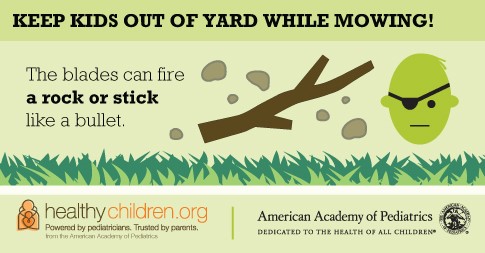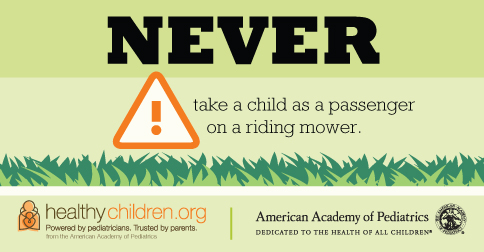Power lawn mowers are one of the most dangerous tools around the home. Each year, more than 5,000 children are treated in emergency departments for injuries caused by power mowers. Older children and teens are most often hurt while cutting lawns as chores or as a way to earn money.
Injuries from lawn mowers
Lawn mowers injuries that doctors see include deep cuts, loss of fingers and toes, broken and dislocated bones, burns, injuries to the eye and other body parts. Some injuries are very serious. Both users of mowers and those who are nearby can be hurt.
The good news is that most lawn mower-related injuries can be prevented with some simple precautions. Keep reading for important safety tips.
When are kids old enough to mow the lawn?
Before learning how to mow the lawn, your child should show the maturity, good judgment, strength and coordination that the job requires. In general, the American Academy of Pediatrics recommends that children should be at least
It is important to teach your child how to use a lawn mower. Before you allow your child to mow the lawn alone, spend time showing them how to do the job safely. Supervise your child's work until you are sure that they can manage the task alone.
Before mowing the lawn:
 Make sure that younger children are indoors or at a safe distance, well away from the area that you plan to mow.
Make sure that younger children are indoors or at a safe distance, well away from the area that you plan to mow.
Try to use a mower with a control that stops the blade and forward motion if the handle is let go.
Read the lawn mower operator's manual and the instructions on the mower.
Check the conditions outside:
- Clear the mowing area of any objects such as twigs, stones and toys that could be picked up and thrown by the lawn mower blades.
Make sure that protective guards, shields, the grass catcher and other types of safety equipment are placed properly on the lawn mower.
Use a collection bag for grass clippings or a plate that covers the opening where grass is released.
Make sure that blade settings (to set the wheel height or dislodge debris) are done by an adult, with the mower off and the spark plug removed or disconnected.

If your lawn mower is electric, use a ground fault circuit interrupter to prevent electric shock.
While mowing:
Have anyone who uses a mower wear hearing and eye protection and sturdy shoes that cover the toes (not sandals or sneakers)
Use caution when approaching corners, trees, tall grass or anything that might block your view.
If the mower strikes an object, stop, turn the mower off and inspect the mower. If it is damaged, do not use it until it has been repaired.
Do not pull the mower backwards or mow in reverse unless absolutely necessary, and carefully look for children behind you when you mow in reverse.
Use extra caution when mowing a slope:
When a walk-behind mower is used, mow across the face of slopes, not up and down, to avoid slipping under the mower and into the blades.
With a riding mower, mow up and down slopes, not across, to avoid tipping over.
Keep in mind that lawn trimmers also can throw objects at high speed.
Remain aware of where children are and do not allow them near the area where you are working. Children tend to be attracted to mowers in use.
Stop the engine and allow it to cool before refueling
Start and refuel mowers outdoors, not in a garage or shed. Always turn off the mower and wait for the blades to stop completely before:
unclogging the discharge chute or crossing gravel paths, roads or other areas
removing the grass catcher
unclogging the discharge chute
walking away from the mower
Watch this video for more information:
More information